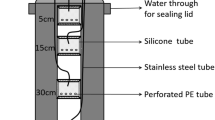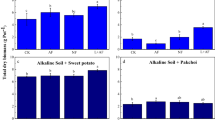Abstract
The effect of topsoil moisture content at the time of nitrogen fertilization and distribution of precipitation following N fertilization on volatile loss of surfaceapplied fertilizer N was studied in two greenhouse experiments using15N-labeled fertilizers. Loss of applied NO -3 -N was small compared with loss of urea-N and diammonium phosphate (DAP)-N; this suggests that NH3 volatilization was the major pathway of N loss for urea and DAP. Loss of applied NO -3 -N averaged less than 6% of that applied regardless of initial topsoil moisture or amount of precipitation. Increased initial topsoil moisture content increased losses of urea-N greatly but losses of DAP-N only slightly. Increasing depths of precipitation, added five days after N fertilization, greatly decreased loss of urea-N but had no effect on the loss of DAP-N. Variations in moisture and precipitation treatments caused losses of urea-N to vary from 40 to 6% of that applied in a slightly acidic silty loam and from 26 to 11% in a calcareous clay. Moisture and precipitation treatments caused volatilization of DAP-N to vary from 20 to 10% in the silty loam and from 40 to 27% in the calcareous clay. In a second experiment, moisture and precipitation conditions affected N loss from urea as in the previous experiment. Addition of phenylphosphorodiamidate (PPDA), a known urease inhibitor, to urea at 20 g kg−1 resulted in only a small reduction of N loss in the calcareous clay soil used.
It was concluded that soil moisture at the time of N fertilization and precipitation following N fertilization can greatly affect volatile loss of fertilizer N. Since the effect of moisture on N loss is not the same for all N sources, moisture parameters are expected to affect the ranking of N sources by their susceptibility to N loss and their uptake by plants in field experiments. Results obtained suggest some management practices by which fertilizer N might be conserved. The great effect of moisture and precipitation on N loss in these studies underscores the need for detailed meteorological records for field sites of N trials.
Similar content being viewed by others
References
Aggarwal RK and Kaul P (1978) Loss of nitrogen as ammonia volatilization from urea on loamy sand soil of Jodhpur. Annals of Arid Zone 17:242–245
Buresh RJ, Austin ER and Craswell ET (1982) Analytical methods in15N research. Fert Res 3:37–62
Bouwmeester RJB, Vlek PLG and Stumpe JM (1985) Effect of environmental factors on NH3 volatilization from a urea-fertilized soil. Soil Sci Soc Am J 49:376–381
El-Zahaby EM, Chien SH, Savant NK, Vlek PLG and Mokwunye AU (1982) Effect of pyrophosphate on phosphate sorption and ammonia volatilization by calcareous soils treated with ammonium phosphates. Soil Sci Soc Am J 46:733–740
Ernst JW and Massey HF (1960) The effects of several factors on volatilization of ammonia formed from urea in the soil. Soil Sci Soc Am Proc 24:87–90
Fenn LB, Matocha JE and Wu E (1982) Soil cation exchange capacity effects on ammonia loss from surface-applied urea in the presence of soluble calcium. Soil Sci Am J 46:78–81
Fenn LB and Miyamoto S (1981) Ammonia loss and associated reactions of urea in calcareous soils. Soil Sci Soc Am J 45:537–540
Ferguson RB, Kissel DE, Koelliko JK and Basel W (1984) Ammonia volatilization from surface-applied urea: effect of hydrogen ion buffering capacity. Soil Sci Soc Am J 48:578–582
Fox RH and Hoffman LD (1981) The effect of N fertilizer source on grain yield, N uptake, soil pH, and lime requirement of no-till corn. Agron J 73:891–895
Ganry F, Guiraud G and Dommogues Y (1978) Effect of straw incorporation on the yield and nitrogen balance in the sandy soil-pearl millet cropping system of Senegal. Plant and Soil 50:647–662
Gasser JKR (1964) Some factors affecting losses of ammonia from urea and ammonium sulfate applied to soil. J Soil Sci 15:258–272
Hignett TP (1979) Fertilizer Manual, Reference Manual, IFDC-R-1, International Fertilizer Development Center, Muscle Shoals, Alabama
Marshall VG and DeBell DS (1980) Comparison of four methods of measuring volatilization losses of nitrogen following urea fertilization of forest soils. Canadian J Soil Sci 60:549–563
Martens DA and Bremner JM (1984) Effectiveness of phosphoroamides for retardation of urea hydrolysis in soils. Soil Sci Soc Am J 48:302–305
Martin JP and Chapman HD (1951) Volatilization of ammonia from surfacefertilized soils. Soil Sci 71:25–34
Matzel W, Heber R, Ackermann W and Teske W (1978) Ammoniakverluste bei Harnstoffdungung. 3. Beeinflussung der Ammoniakverflüchtigung durch Ureasehemmer. Arch Acker-Pflanzenbau Bodenkunde 22:185–191
Moraghan JT, Rego TJ, Buresh RJ, Vlek PLG, Burford JR, Singh S and Sahrawat KL (1984) Labeled nitrogen fertilizer research with urea in the semi-arid tropics: 2. Field studies on a Vertisol. Plant and Soil 80:21–33
Moraghan JT, Rego TJ and Buresh RJ (1984) Labeled nitrogen fertilizer research with urea in the semi-arid tropics: 3. Field studies on an Alfisol. Plant and Soil 82:193–203
More SD and Varade SB (1978) Volatilization losses of ammonia from different nitrogen carriers as affected by soil moisture, organic matter, and method of fertilizer application. J Indian Soc Soil Sci 26:112–115
Overrein LN and Moe PG (1967) Factors affecting urea hydrolysis and ammonia volatilization in soil. Soil Sci Soc Am Proc 31:57–61
Simpson JR (1968) Losses of urea nitrogen from the surface of pasture soils. Trans 9th Int. Congr. Soil Sci., Madison, Wisconsin, 459–466
van Burg PFJ, Dilz K and Prins WH (1982) Agricultural value of various nitrogen fertilizers, Netherlands Nitrogen Technical Bulletin Number 13
Vlek PLG and Carter MF (1983) The effect of soil environment and fertilizer modification on the rate of urea hydrolysis. Soil Sci 136:56–63
Volk GM (1961) Gaseous loss of ammonia from surface-applied nitrogenous fertilizers. J Agric Food Chem 9:280–283
Author information
Authors and Affiliations
Rights and permissions
About this article
Cite this article
Stumpe, J., Monem, M.A. Greenhouse evaluation of the effect of topsoil moisture and simulated rainfall on the volatilization of nitrogen from surfaceapplied urea, diammonium phosphate, and potassium nitrate. Fertilizer Research 9, 229–239 (1986). https://doi.org/10.1007/BF01050349
Accepted:
Issue Date:
DOI: https://doi.org/10.1007/BF01050349




